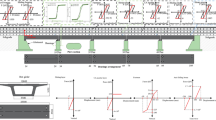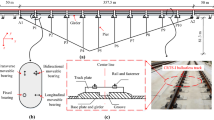Abstract
The vehicle-track-bridge (VTB) element was used to investigate how a high-speed railway bridge reacted when it was subjected to near-fault directivity pulse-like ground motions. Based on the PEER NAG Strong Ground Motion Database, the spatial analysis model of a vehicle-bridge system was developed, the VTB element was derived to simulate the interaction of train and bridge, and the elasto-plastic seismic responses of the bridge were calculated. The calculation results show that girder and pier top displacement, and bending moment of the pier base increase subjected to near-fault directivity pulse-like ground motion compared to far-field earthquakes, and the greater deformation responses in near-fault shaking are associated with fewer reversed cycles of loading. The hysteretic characteristics of the pier subjected to a near-fault directivity pulse-like earthquake should be explicitly expressed as the bending moment-rotation relationship of the pier base, which is characterized by the centrally strengthened hysteretic cycles at some point of the loading time-history curve. The results show that there is an amplification of the vertical deflection in the girder’s mid-span owing to the high vertical ground motion. In light of these findings, the effect of the vertical ground motion should be used to adjust the unconservative amplification constant 2/3 of the vertical-to-horizontal peak ground motion ratio in the seismic design of bridge.
Similar content being viewed by others
References
HOUSNER G W, HUDSON D E. The Port Hueneme earthquake of march 18, 1957 [J]. Bulletin of Seismological Society of America, 1958, 48(2): 163–168.
BOLT B A. The San Fernando Valley, California earthquake of February 9, 1971: Data on seismic hazards [J]. Bulletin of Seismological Society of America, 1971, 61(2): 501–510.
BERTERO V V, MAHIN S A, HERRERA R A. Aseismic design implications of near-fault San Fernando earthquake records [J]. Earthquake Engineering and Structural Dynamics, 1978, 6(1): 31–42.
HE Wan-long, AGRAWAL A K. Analytical model of ground motion pulses for the design and assessment of seismic protective systems [J]. ASCE Journal of Structural Engineering, 2008, 134(7): 1177–1188.
MENUN C, FU Q. An analytical model for near-fault ground motions and the response of SDOF systems [C]// Earthquake Engineening Research Institute. Proceedings of the 7th US National Conference on Earthquake Engineering. Boston, MA, USA: Mira Digital Publishing, 2002: 1477–1486.
MAVROEIDIS G P, DONG G, PAPAGEORGIOU A S. Near-fault ground motions, and the response of elastic and inelastic single-degree-of-freedom (SDOF) systems [J]. Earthquake Engineering & Structural Dynamics, 2004, 33(9): 1023–1049.
ALAVI B, KRAWINKLER H. Consideration of near-fault ground motion effects in seismic design. [C]// New Zealand Society for Earthquake Engineering. Proceedings of the 12th World Conference on Earthquake Engineering. Auckland, New Zealand, A. A. Balkema, 2000: No. 2665.
UANG C M, BERTERO V V. Implications of recorded earthquake ground motion on seismic design of building structures UCB/EERC-88/13 [R]. Berkeley: Earthquake Engineering Research Center, University of California, 1988.
HALL J F, HEATON T H, HALLING M W. Near-source ground motion and its effects on flexible buildings [J]. Earthquake Spectra, 1995, 11(4): 569–606.
TANG Yu-chuan, ZHANG Jian. Response spectrum-oriented pulse identification and magnitude scaling of forward directivity pulses in near-fault ground motions [J]. Soil Dynamics and Earthquake Engineering, 2011, 31(1): 59–76.
YAHYAABADI A, TEHRANIZADEH M. New scalar intensity measure for near-fault ground motions based on the optimal combination of spectral responses [J]. Scientia Iranica, 2011, 18(6): 1149–1158.
GILLIE J L, ADRIAN R M, McDANIEL C. Strength reduction factors for near-fault forward-directivity ground motions [J]. Engineering Structures, 2010, 32(1): 273–285.
KALKAN E, KUNNATH S K. Effects of fling step and forward directivity on seismic response of buildings [J]. Earthquake Spectra, 2006, 22(2): 367–390.
CHEN Ling-kun, JIANG Li-zhong, Wang Li-ping, LUO Bo-fu. Analysis of elasto-plastic seismic response of high-speed railway bridge with round-ended piers [J]. Journal of South China University of Technology (Natural Science), 2011, 39(6): 126–131. (in Chinese)
CHEN Ling-kun, JIANG Li-zhong, YU, Zhi-wu, ZENG Zhi-ping. Study on earthquake characteristics of high-speed railway simply-supported girder bridge [J]. Journal of Vibration and Shock, 2011, 30(12): 216–222. (in Chinese)
CHEN Ling-kun, JIANG, YU Zhi-wu, ZENG Zhi-ping. Numerical analysis of seismic responses of high-speed railway bridge round-ended piers [J]. Journal of Hunan University (Natural Sciences), 2012, 39(4): 19–25. (in Chinese)
CHEN Ling-kun, JIANG, ZENG Zhi-ping, LONG Wei-guo. Numerical modeling and simulation on seismic performance of high-speed railway bridge system [J]. Noise and Vibration Worldwide, 2011, 42(10): 15–22.
LIAO Wen-I, LOH Chin-Hsiung, LEE Bor-Han. Comparison of dynamic response of isolated and non-isolated continuous girder bridges subjected to near-fault ground motions [J]. Engineering Structures, 2004, 26(14): 2173–2183.
LIAO Wen-I, LOH Chin-Hsiung, WAN Shiuan, JEAN Wen-Yu, CHAI Juin-Fu. Dynamic response of bridges subjected to near-fault ground motions [J]. Journal of Chinese Institute of Engineering, 2000, 23(4): 455–464.
LIU Qing-hua, YAN Gui-ping, CHEN Ying-jun. Experimental studies on seismic behaviour of reinforced concrete bridge piers [J]. Journal of Northern Jiaotong University, 1996, 20(5): 518–521. (in Chinese)
KALKAN E, KUNNATH S K. Effects of fling step and forward directivity on seismic response of buildings [J]. Earthquake Spectra, 2006, 22(2): 367–390.
HOON C M. SAIID S, PAUL S, SAAD E A. Experimental study of reinforced concrete bridge columns subjected to near-fault ground motions [J]. ACI Structural Journal, 2010, 107(1): 3–12.
JU Yan-zhong., YAN Gui-ping, LIU Lin. Experimental study on seismic behaviors of large-scale RC round-ended piers with low reinforcement ratio [J]. China Civil Engineering Journal, 2003, 36(11): 66–69. (in Chinese)
SHEN J, TSAI M H, CHANG K C, LEE G C. Performance of a seismically isolated bridge under near-fault earthquake ground motions [J]. Journal of Structure Engineering, ASCE, 2004, 130(6): 861–868.
SOMERVILLE P G. Magnitude scaling of the near fault rupture directivity pulse [J]. Physics of the Earth and Planetary Interiors, 2003, 137(1), 201–212.
BAKER J. Quantitative classification of near-fault ground motions using recordlet analysis [J]. Bulletin of Seismological Society of America, 2007, 97(5): 1486–1501.
SOMERVILLE P G, SMITH N F, GRAVES R W, ABRAHAMSON N A. Modification of empirical strong motion attenuation relations to include the amplitude and duration effects of rupture directivity [J]. Seismological Research Letters, 1997, 68(1): 180–203.
ZHANG Nan, XIA He. Dynamic analysis of coupled vehicle-bridge system based on inter-system iteration method [J]. Computers & Structures, 2013, 114–115: 26–34.
GAO Mang-mang. Studies on train-track-bridge coupling vibration and train performance on high-speed railway bridges [J]. China Railway Science, 2002, 23(2): 135–137. (in Chinese)
LI Xiao-zhen, ZHU Yan, QIANG Shi-zhong. Stochastic response analysis of train-bridge coupling system under high speed train loads excitation [J]. Journal of Vibration and Shock, 2012, 31(4): 168–172. (in Chinese)
JO J S, JUNG H J, KIM H. Finite element analysis of vehicle-bridge interaction by an iterative method [J]. Structural Engineering & Mechanics, 2008, 30(2): 165–76.
YANG Yeong-bin, YAU Jong-dar. Vehicle-bridge interaction element for dynamic analysis [J]. Journal of Structural Engineering, ASCE, 1997, 123(11): 1512–1518.
YANG Yeong-bin, WU Yean-seng. A versatile element for analyzing vehicle-bridge interaction response [J]. Engineering Structures, 2001, 23(5): 452–469.
CHEUNG Yuan-sheng, AU Francis-Tat-Kwong, CHEUNG Yau-kai. Vibration of railway bridges under a moving train by using bridge-track-vehicle element [J]. Engineering Structures, 2001, 23(12): 1597–1606.
NIELSEN J C O, ABRAHAMSSON T J S. Coupling of physical and modal components for analysis of moving non-linear dynamic systems on general beam structures [J]. International Journal for Numerical Methods in Engineering, 1992, 33(9): 1843–1859.
YAU Jong-dar, YANG Yeong-bin, KUO Shyh-rong. Impact response of high speed rail bridges and riding comfort of rail cars [J]. Engineering Structures, 1999, 21(9): 836–844
JIANG Cheng, LIN Zhi-min. Test and research on the ballast-free track structure for high-speed railway [J]. Chinese Railways, 2000, 7: 22–24. (in Chinese)
HWANG E S, NOWAK A S. Simulation of dynamic load for bridges [J]. Journal of Structural Engineering, ASCE, 1991, 117(5): 1413–34.
YANG F, FONDER G A. An iterative solution method for dynamic response of bridge-vehicle systems [J]. Earthquake Engineering & Structure Dynamics, 1996, 25(2): 195–215.
CHEN Ling-kun. Seismic responses of high-speed railway train-ballastless track-bridge system and train-running safety during earthquake [D]. Changsha, China: School of Civil Engineering, Central South University, 2012. (in Chinese)
CHEN Ling-kun, JIANG Li-zhong, YU Zhi-wu, ZENG Zhi-ping. Numerical analysis of seismic responses of high-speed railway bridge round-ended Piers [J]. Journal of Hunan University (Natural Sciences). 2012, 39(4): 19–25. (in Chinese)
GB50111-2010. Code for seismic design of railway engineering [S]. Beijing: China Planning Press, 2010. (in Chinese)
FEMA-356. Prestandard and commentary for seismic rehabilitation of buildings [S]. Washington DC: Federal Emergency Management Agency, 2000.
ABRAHAMSON N A, LITEHISER J J. Attenuation of vertical peak acceleration [J]. Bulletin of the Seismological Society of America, 1989, 79: 549–580.
NIAZI M, BOZORGNIA Y. Behaviour of near-source peak horizontal and vertical ground motions over SMART-l array, Taiwan [J]. Bulletin of the Seismological Society of America, 1991, 81: 715–732.
BRODERICK B M, ELNASHAI A S, AMBRASEYS N N, BARR J M, GOODFELLOW R G., HIGAZT E M. The Northridge (Ca1ifomia) earthquake of 17 January 1994: Observations, strong motion and correlative response analyses. Research Report ESEE-94/4 [R]. London: Imperial College, 1994.
ELNASHAI A S, PAPAZOGLOU A J. Vertical earthquake ground motion: Evidence, effects and simplified analysis procedures. ESEE 95-06 [R]. London: Civil Engineering Dept, Imperial College, 1995.
Author information
Authors and Affiliations
Corresponding author
Additional information
Foundation item: Project(2013CB036203) supported by the National Basic Research Program of China; Project(2013M530022) supported by China Postdoctoral Science Foundation; Project(2013-K5-31) supported by Science and Technology Plan of Ministry of Housing and Urban-Rural Development of China; Project supported by High-level Scientific Research Foundation for the Introduction of Talent of Yangzhou University, China; Project supported by the Open Fund of the National Engineering Laboratory for High Speed Railway Construction, China; Project(IRT1296) supported by the Program for Changjiang Scholars and Innovative Research Team in University, China; Project(50908236) supported by the National Natural Science Foundation of China
Rights and permissions
About this article
Cite this article
Chen, Lk., Zhang, N., Jiang, Lz. et al. Near-fault directivity pulse-like ground motion effect on high-speed railway bridge. J. Cent. South Univ. 21, 2425–2436 (2014). https://doi.org/10.1007/s11771-014-2196-9
Received:
Accepted:
Published:
Issue Date:
DOI: https://doi.org/10.1007/s11771-014-2196-9




